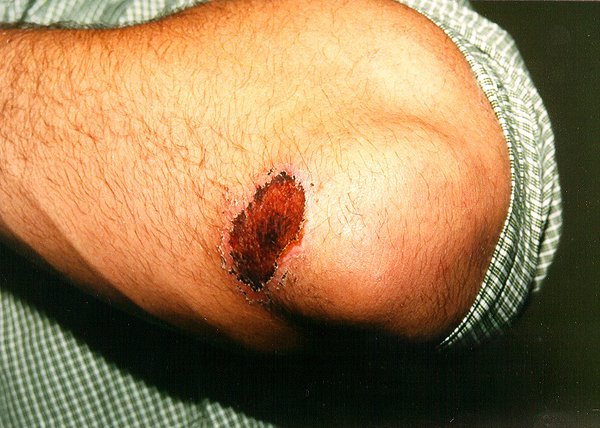What is a wound? A wound is type of injury to the skin in which the skin is cut open or had a blunt trauma wherein the wound is inside the skin. It can be an open or a closed wound. In the classification of an open wound, the skin may be abraded, torn, cut or punctured. In the case of a closed wound, wherein the skin is not open because it is caused of a blunt trauma, there could be a contusion or a hematoma or bruising. A hematoma is a sign that there is an internal bleeding which can be mild or hemorrhage.
 Wound healing is a complex yet orderly phenomenon involving a number of processes. Almost all people reading this article may have experienced having a wound. The classic signs and symptoms of a having a wound are redness, pain, warmness, inflammation and sometimes having loss of function. After an injury, our bodies have the capability to heal but needs to undergo a few processes such as coagulation, inflammation, fibroplasia, and wound remodeling to be able to return to its former state.
Wound healing is a complex yet orderly phenomenon involving a number of processes. Almost all people reading this article may have experienced having a wound. The classic signs and symptoms of a having a wound are redness, pain, warmness, inflammation and sometimes having loss of function. After an injury, our bodies have the capability to heal but needs to undergo a few processes such as coagulation, inflammation, fibroplasia, and wound remodeling to be able to return to its former state.
Coagulation
The skin is the largest organ system covering our internal organs. It acts as a protective anatomical barrier from pathogens that may cause diseases to the insides of the body. There is a disruption of blood vessels in a case of the wound. A sign of it can be bleeding or bruising. The blood vessels function after an injury to the blood vessels is to constrict or to minimize the diameter of the blood vessels in order to minimize also the bleeding. The small blood capillaries become more permeable and so to stop the bleeding, platelets are activated and they move to the site of the wound for the blood to clot. A number of cells called the inflammatory cells move near the site of injury and so the inflammatory responses are exhibited—these are the redness, swelling, warmness, pain and sometimes even temporary loss of function. When there is pain, we try to avoid to move the site in order for it to stop further injury and bleeding.
Inflammation
Now that there are the signs and symptoms of inflammation, more white blood cells migrate into the site of the wound. White blood cells have properties that protect the body from pathogens or disease producing substances that are found in the environment and because the skin is disrupted, the white blood cells are activated to prevent the wound from having infection. Some types of white blood cells have macrophages which a very minute bacteria eating cells that kill the process of developing an infection. They remove microbes and cellular debris before they grow fast.
Fibroplasia
Protein is needed for tissue repair. In this phase, the ground substance is produced within the matrix. The ground substance is transparent, viscous fluid that is found in the connective tissues of our body. It has the appearance and consistency of raw egg whites and is rich in protein, surrounds all the cells of the body. New blood vessels are formed again or the former damaged blood vessels are now healed. In this phase, the inflammation subsides and fibroblasts, cells that give rise to connective tissues, migrate and proliferate in the wound as triggered by chemotactic and growth factors and has fibroblasts populate the wound, they begin to synthesize and secrete proteoglycans, collagen and elastic which give the healing tissue strength. Until the person’s collagen is laid down, wound strength is provided for by the fibrin in the clot or scab. A fibrin is an elastic, insoluble protein produced by the clotting factors in the blood and forming an interlacing or patchwork network of fibers in the coagulation of blood, thus a scab is formed. Wound contraction continues until the edges of the wound meet and gradually decrease the size of the wound. Here the collagen production returns to normal.
Wound Remodeling
 This is called the maturation phase of wound healing. The wound heals and there is scar formation. The original collagen that laid down now breaks down and is replaced by new collagen, which is strong and good as new. This new collagen has more cross-links, thereby increasing the strength of the scar. In some cases, after wound healing, the collagen that was laid down by the process of healing is very strong and sometimes leaves a greater sign called a keloid which can be a lot stronger than an ordinary healed wound without a keloid. People who are keloid formers always have a scar that is difficult to remove and sometimes requires several treatments in order to lighten it up.
This is called the maturation phase of wound healing. The wound heals and there is scar formation. The original collagen that laid down now breaks down and is replaced by new collagen, which is strong and good as new. This new collagen has more cross-links, thereby increasing the strength of the scar. In some cases, after wound healing, the collagen that was laid down by the process of healing is very strong and sometimes leaves a greater sign called a keloid which can be a lot stronger than an ordinary healed wound without a keloid. People who are keloid formers always have a scar that is difficult to remove and sometimes requires several treatments in order to lighten it up.
